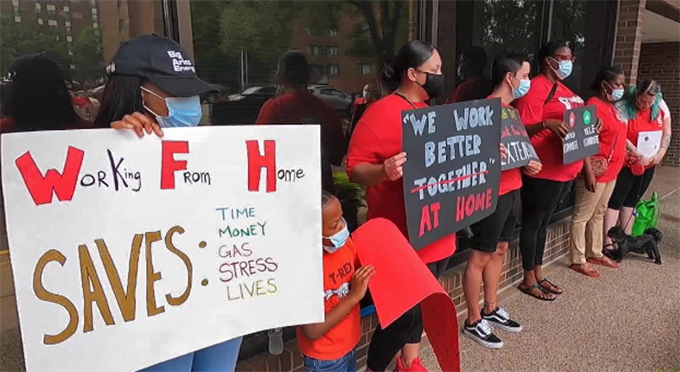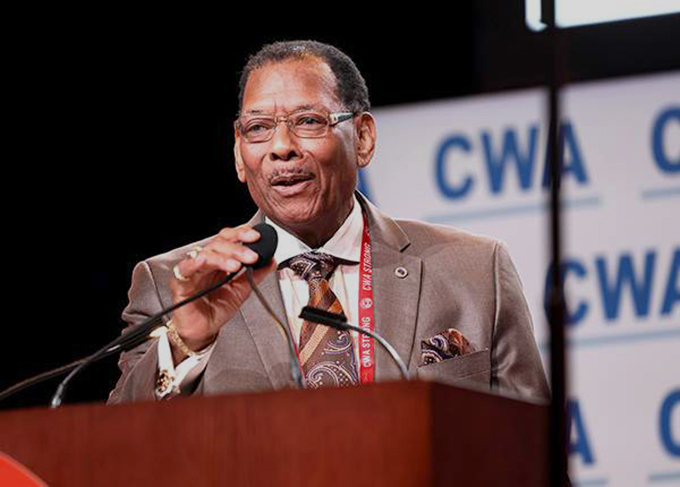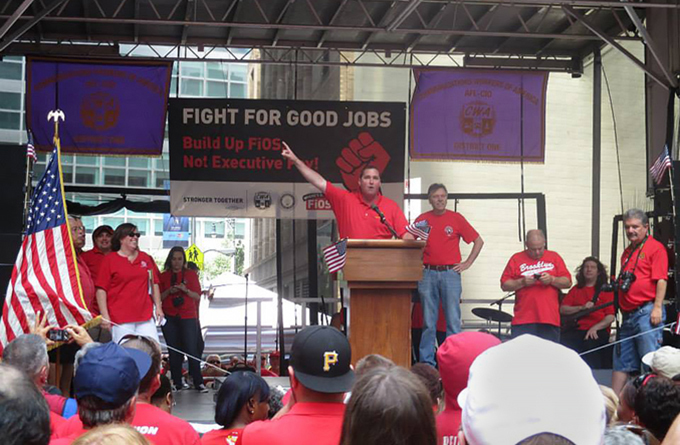Which Side Are You On?
By Steve Early
Bosses, Union Officials and Rank & Filers Debate Work from Home

Work from home arrangements proliferated during the pandemic and became very popular among white-collar workers. They are now the subject of a tug of war between labor and management because high profile bosses—like Mark Zuckerberg at Meta, Elon Musk at Twitter, Jamie Dimon at JP Morgan Chase, and Andy Jassy at Amazon–have decreed that it’s time to get back in the office.
Such mandates have triggered widespread resistance, even among workers without collective bargaining rights. At Amazon, for example, more than 20,000 employees signed a petition urging Jassy to reconsider his May 1 deadline for everyone showing up at least three days per week, with few exceptions. On May 31 in Seattle, more than 1,000 people walked off the job, for one hour during lunchtime, to protest this “harmful, unilateral decision.” Another 2,000 Amazon employees engaged in similar solidarity actions worldwide.
In the public sector, a work-stoppage earlier this year by 150,000 federal employees in Canada resulted in what three labor researchers call “important steps toward an ongoing work-from-home protocol.” These include “requiring that remote work requests be evaluated individually, not by group of employees, and the creation of joint employer-union committees in each department to oversee the future evolution of remote work practices.”
Another commentator hailed this Public Service Alliance of Canada (PSAC) side agreement as a big win in the “on-going power struggle to determine who has the authority to define work conditions.” According to this observer, “remote work…is a front on which organized labor should give its all to secure better arrangements for all workers.”
A CWA Campaign Issue
Within one major AFL-CIO union, there has been less unanimity that work-from-home/hybrid schedules are a good thing—and worth defending and extending.
In the Communications Workers of America (CWA), tens of thousands of members in telecom, the public sector, higher education, the media, and airlines all worked from home during the pandemic and got to like it. As a result, WFH became one important issue in a rare contested election for CWA national president.

That three-way race ended last Monday, July 10, in St. Louis, when 940 union convention delegates cast ballots on behalf of 360,000 members in the U.S. and Canada. They picked 71-year-old Claude Cummings Jr.,a CWA Vice-President and civil right leader from Texas, who is now the union’s first African-American president. Both Cummings and former NewsGuild organizer Sara Steffens–who was eliminated in the first round of voting but then backed Cummings in the second–pledged to defend WFH in new and old bargaining units.
“… service reps in Minneapolis had discovered that remote work “was safer, saved them money on commuting and childcare, gave them more time for rest and with their families and more control of their workspace.”
They argued that CWA would not be well-positioned to help more white-collar workers win bargaining rights and contract language on WFH if top union officials opposed remote work options. In contrast, the third candidate–CWA Vice-President Ed Mooney, a longtime telecom industry negotiator– was an internal critic of WFH agreements and objected to continuing one at Verizon. “Everybody liked work from home,” he acknowledged, in a May 15 candidate debate. But, according to Mooney, WFH has put “the companies in the driver’s seat because they are aware our members like it so much.”
Taking that contested position, while also being dogged by accusations of personal misconduct, proved fatal to Mooney’s candidacy. He lost to Cummings, in the run-off, by a margin of 59% to 41% among the delegates voting.
AT&T Worker Protest
Last September, it was thousands of AT&T call center workers who felt like losers when management ordered them back to work. According to Local 7250 President Kieran Knutson, his fellow customer service reps in Minneapolis had discovered that remote work “was safer, saved them money on commuting and childcare, gave them more time for rest and with their families and more control of their workspace.”
That’s why Knutson and leaders of other AT&T locals launched a grassroots campaign aimed at keeping Work from Home (WFH) as an option at AT&T, the most heavily unionized telecom company. They organized protests and press conferences which drew national drew media attention in outlets like CBS Evening News,Fortune, and The Guardian. They collected 8,000 rank-and-file signatures on a petition demanding WFH as a permanent option for customer service reps and teleconference specialists, communications techs, and workers in other eligible titles. The pro-WFH petitioners also expressed solidarity with fellow CWA members who “do want to work at a central business location and support keeping that option as well.”
In Knutson’s view, this grassroots initiative “didn’t get much support” from top CWA officials who negotiate with AT&T on agreements covering 70,000 workers around the country. Frustrated that the “union has gotten so used to a top-down model where leaders tell the members what’s important,” rather than the other way around, Knutson joined two ad hoc committees that challenged the presidential candidates on key issues, including WFH and, in Mooney’s case, his alleged non-compliance with CWA’s policy on “mutual respect”.
Union Strategy on WFH
Differences quickly emerged in their responses to questions posed during CWA’s first ever CWA presidential debate on May 15, organized by Knutson’s local and seven others (or a related candidate questionnaire that only Mooney ignored.) Cummings, a leading CWA negotiator with AT&T, reiterated his support for Local 7250’s petition last year because he “recognized early during the pandemic that our members were enjoying WFH.” Cummings also argued that more job flexibility can be achieved through periodic contract negotiations, so-called “effects bargaining,” and “a strong mobilization effort for WFH during negotiations.” The now-CWA president noted that rank-and-filers covered by WFH deals need a “strong and effective network” of “empowered job stewards.”
“Proper tools, training and education is essential to the success of this process,” Cummings said. “Zoom membership meetings and quarterly gatherings such as ‘Union Days’ that include educational programs along with outreach can help keep our members engaged and connected to their local unions.” While he served as CWA Vice-President and director of the union’s fourth largest district, Cummings own staff of organizers and reps worked from home, and he reported no membership complaints about that.
Drawing on her background as a media industry organizer and negotiator, Steffens called WFH “a major quality-of life benefit, as important as pay and job security, for our members in jobs where it’s possible.” She argued that CWA should do more to “collect and share best practices for work from home, including model contract language on critical issues like new hire data and orientations, remote surveillance, equipment reimbursement and callback protections.”
To deal with the internal and external organizing challenges created by remote work arrangements, Steffens called for better national union “systems to support hybrid and home-based workers and units, including funding home visits, organizing blitzes, electronic membership cards, virtual union boards and other strategies to ensure that our union density and activism remains strong.”
Remote Work Skeptics
… some rank-and-file radicals who belong to those locals [of techs felt] WFH “takes away our bargaining power, leaves people more atomized, and gives management too much control.”
Former Pennsylvania Bell technician Ed Mooney took the most critical view of WFH. During the pandemic, the CWA staff directed by Mooney in the mid-Atlantic states was ordered to return to union offices long before their counterparts elsewhere did so, according to the CWA staff union. On work-from-home in telecom, Mooney told debate listeners in May that “the whole world is trying to figure out is this a “flavor of the month” kind of thing for employers?’ Are they going to do it just to eliminate workers? Are they going pull them back and forth? So, when we go and bargain this stuff, we have to make sure we get protections.” He predicted much more “push and pull” over hybrid work schedules until “we get this to a spot where it’s mutually beneficial.”
Mooney defended his role in negotiations with Verizon over WFH last year. During those talks, other CWA bargaining committee members like Local 1400 President Don Trementozzi had to overcome Mooney’s initial opposition—voiced during union caucuses– to extending remote work opportunities for Verizon customer service reps.
Then and now, Mooney’s questioning of WFH resonated not only with east coast Verizon locals, dominated by technicians, but also some rank-and-file radicals who belong to those locals. Echoing Mooney’s concerns, one long-time activist and fellow Labor Notes supporter told me that WFH “takes away our bargaining power, leaves people more atomized, and gives management too much control.”
Another Verizon tech in Pennsylvania described both an upside and a downside to his experience with “home garaging” during the pandemic. Most of his co-workers really liked not having to report to a Verizon garage to pick up and return their trucks on a daily basis. With no unpaid commuting time, he found himself “actually working an 8-hour day for the first time ever.”
On the other hand, the job of CWA stewards became much harder because the “organic organizing opportunities” created by work group meetings, before and after daily shifts, no longer existed. Face-to-face contact was replaced with phone calls and much more e-mailing back and forth, in response to questions about workplace issues, management policy changes, or the status of grievances. There was, he reported, a “loss of cohesion” that might undermine “strike capacity” in the future.
Three decades ago, I was similarly ambivalent. As a national union rep between 1980 and 2007, I had much first-hand familiarity with the workplace culture of telephone company service reps and the different (and more blue-collar) world of inside and outside “plant technicians.” I also worked with cable TV and telco technicians in CWA and IBEW who had divergent views on “home garaging” many years ago. Most cable guys loved being able to take their trucks home at night and go directly to customers’ homes the next morning. Union-minded telephone techs wanted their co-workers to report to a central location every day, so they would have more regular contact with shop stewards.
After I helped a group of 1,500 customer service reps in New England get a first contract in the mid-1990s, it wasn’t long before the company now known as Verizon wanted to do a “trial” of work from home. One reason for our resistance to that proposal was the fear that collective action in newly organized call centers would be more difficult if everyone was isolated at home and not working under the same roof.
CWA’s WFH Defenders
The availability of now well-tested new tools for communication, coordination, and membership participation–that were not available back then–has convinced me that greater union flexibility on this issue is absolutely essential. One local union leader who has been most persuasive on this topic is Don Trementozzi, a former customer service rep, longtime Labor Notes supporter, and founding member of Labor for Bernie in 2015.
No stranger to union militancy, Trementozzi has been involved in two major Verizon strikes, a local work stoppage at AT&T Mobility, and the nation’s longest walkout in 2014, a successful fight by 2,000 workers against contract concessions at FairPoint Communications that lasted 131 days. Trementozzi’s fast-growing Local 1400 is based in New England and reflects the unusual occupational diversity of CWA nationally.
By the end of last year, its 2,700 members included customer service and sales reps in call centers or retail stores, media and manufacturing workers, soft-ware developers, data center staff, and local government employees. Trementozzi also helped nurture and support the Alphabet Workers Union, a self-organized group at Google, that grew to over 1,000 members while working remotely and now have their own newly-chartered Local 9009 in California, where the company is based.
According to Trementozzi, rank-and-file participation in his local actually increased during the pandemic. Because bargaining sessions, committee meetings and general membership gatherings were conducted via Zoom, they attracted people who would not have attended in person, after working all day or all week in their previous work locations. Local 1400 continued to have exceptional success recruiting new members, including those working remotely while they campaigned for union recognition.
Trementozzi believes that WFH “addresses a key quality of life issue for hundreds of thousands of workers we represent and even more we are trying to organize. In every contract survey, CWA members have told us to make this a key proposal at the bargaining table.” His experience butting heads with Mooney over the WFH extension at Verizon last year turned him into a supporter of Steffens’ candidacy, despite her non-telephone industry background.
Trementozzi ultimately became her campaign manager and, after her defeat on July 10, urged other Steffens supporters to back Cummings in the run-off, insuring the latter’s victory over Mooney. When polled before the convention, AT&T workers in Minneapolis Local 7250 overwhelmingly backed Cummings. So WFH defender Kieran Knutson and other delegates from his local voted for the eventual winner in both rounds of balloting. Both Trementozzi and Knutson hope that CWA’s unusual campaign debate over the future of work from home will contribute to more member-driven organizing and bargaining strategies in their own union and others, to the benefit of all workers.
…
(Steve Early was involved in organizing, bargaining, and strikes at AT&T and Verizon for 27 years, while serving as a Boston-based CWA International Representative. He now belongs to a NewsGuild/CWA Freelancers Unit in the Bay Area and was a supporter of Sara Steffens campaign for CWA President. A different version of this article appeared originally in In These Times.)

